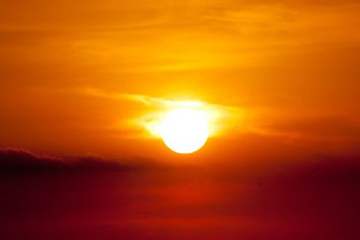Ancestors of the Sun

(ISNS) -- Astronomers love to say that we are all made of elements forged in the bellies of giant stars and exploded into vast clouds of stellar debris. But they rarely tell us the details of the solar system's stellar genealogy.
Now a pair of researchers has combined measurements of radioisotopes in meteorites with models to trace the probable lineage of the matter that makes up our bodies and our planet to the mother and grandmothers of the sun.
The ancestry traces back to shortly before the sun formed, about 4.6 billion years ago, within approximately 100 light years of where the sun now shines. The radioactive varieties of two familiar metals -- the isotopes known as aluminum-26 (Al-26) and iron-60 (Fe-60) -- produce revealing clues for the sun's ancestry.
Both metals could be found in meteorite chondrules, the once-molten globs of calcium, aluminum and other elements that were the very first things to form in the disk of gas orbiting the newly born sun. Both Al-26 and Fe-60 decay relatively quickly, but have left behind their daughter elements, magnesium-26 and cobalt-60, as clues to their abundance in ancient meteorites, explain researchers Matthieu Gounelle of the French National Museum of Natural History and Centre National de la Recherche Scientifique and Georges Meynet of the Geneva Observatory in Switzerland.
"The story begins with the detection of Al-26 in meteorites," said Meynet. "It's been known...for a long time now and was injected into the cloud that the sun was born from."
With a mean lifetime of just 1.1 million years, the presence of Al-26 in chondrules means it was blasted into the region where the sun would be born shortly before the sun's formation. It is, in other words, the smoking gun of the stellar explosions that kick-started the formation of the sun and solar system out of a nursery cloud of gas.
But that's where the other radioisotope, Fe-60, comes into the story and messes it all up, said Meynet. The calculated amounts of Fe-60 are all wrong for it to have also been injected by the same supernova.
Sign up for the Live Science daily newsletter now
Get the world’s most fascinating discoveries delivered straight to your inbox.
"You have to ... fine-tune the models for it to work," said Meynet. "The supernova has to be in the perfect position. What Gounelle has proposed here is a different scenario that is much more general."
Gounelle's scenario starts with a gas cloud as well, but in it there is a stellar brushfire. The sun would have resulted from a third wave of ignitions.
"The (longer-lived) Fe-60 was produced by many supernovae two stellar generations back," said Meynet, "While the Al-26 was injected by one later supernova that started the collapse of the cloud that formed the Sun and its siblings."
Meynet believes the deaths of the largest and shortest-lived stars in that first generation produced Fe-60 and enriched the stellar nursery cloud just a few millions years after they began forming, and within 100 light years of where the sun was later formed. The winds and explosions of those stars triggered the collapse of other parts of the cloud, which created a second generation of stars. The powerful stellar winds and, ultimately, the explosive death of one of the large stars in this second generation, just a few light-years away and a few million years later added the Al-26 and sparked the collapse of gases to create the sun about 4.6 billion years ago. Unlike the stars that generated the radioisotopes, our sun is much smaller and therefore much longer-lived than its mother and grandmother.
This scenario has been described in a paper the two researchers have published in the latest edition of the journal Astronomy & Astrophysics.
"The most important point, I would say, is that this star of the second generation is the mother of the sun," Meynet said. "The wind of this star gave rise to the sun and about 100 of its brothers."
"The general idea of sequential star formation is an old idea," commented astrophysicist Scott Kenyon of the Harvard-Smithsonian Center for Astrophysics. But by putting it together with the radioactive isotopes in the meteorites, "I think this is a new twist."
"The advantage of the scenario is that sequential star formation does happen," Kenyon continued. For instance, people have been studying just that sort of event in a loose cluster of stars called the Scorpius-Centaurus Association, he said. .
Kenyon indicated that he thought the idea that the sun was part of an ongoing wave of star-formation was a reasonable argument. "There are a bunch of regions [in the Milky Way] where people can investigate this concept," Kenyon said.
Larry O'Hanlon is a widely published science writer and formerly an online producer, senior correspondent and blogger for Discovery News.
Inside Science News Service is supported by the American Institute of Physics.









